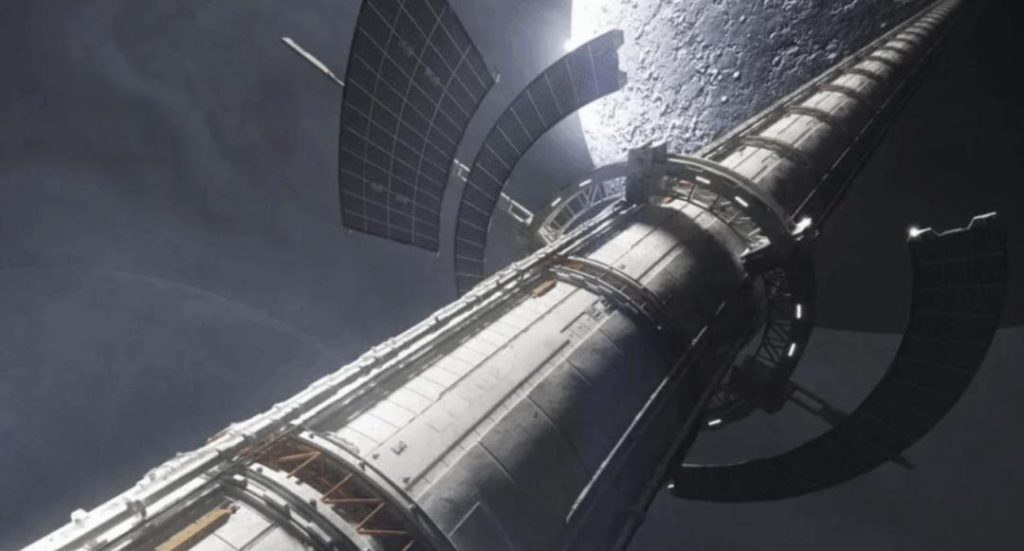
30,000 km-long space elevator on Ceres could aid space travel
The concept of a space elevator has long fascinated scientists and engineers, with its potential to revolutionize space travel and exploration. Now, researchers have proposed a 30,000 km-long space elevator on Ceres, a dwarf planet in the asteroid belt, to extract water and launch payloads more efficiently. Made with carbon nanotubes, the elevator could reduce fuel needs by 15% and energy use by 60%. While this plan shows promise for life support and propulsion, it also faces significant challenges.
Located between the orbits of Mars and Jupiter, Ceres is the largest object in the asteroid belt and has been a target for space agencies and private companies alike. In 2015, NASA’s Dawn spacecraft became the first to orbit Ceres, revealing a surface covered in craters and a mysterious bright spot that has been the subject of much speculation. While Ceres may seem like an unlikely candidate for a space elevator, its proximity to Earth and abundant resources make it an attractive location for a lunar-scale infrastructure.
The proposed space elevator would be anchored to Ceres’ surface and extend to geosynchronous orbit, about 36,000 km above the Earth’s surface. This would allow for the extraction of water from Ceres’ surface and the deployment of payloads into orbit without the need for traditional launch vehicles. The elevator would also enable the transportation of resources and personnel between Ceres and Earth, reducing the need for resupply missions and enabling longer-term human presence on the dwarf planet.
One of the key benefits of the space elevator is its potential to reduce the energy required for space travel. According to researchers, the elevator could reduce fuel needs by 15% and energy use by 60%, making it a more efficient and cost-effective option for space missions. This is because the elevator would allow for the deployment of payloads into orbit using a simple cable-lift mechanism, rather than the complex and energy-intensive process of launching a rocket.
Another advantage of the space elevator is its potential to extract water from Ceres’ surface. Water is a precious resource in space, and the ability to extract it from Ceres would provide a reliable source of life support and propulsion for spacecraft. This could be particularly important for long-duration missions to Mars and beyond, where water is scarce and difficult to obtain.
Despite the potential benefits of the space elevator, it is not without its challenges. One of the biggest hurdles is the need for a reliable power source to support the elevator’s operation. Ceres is a distant location, and the transmission of power from Earth would be difficult and expensive. This could lead to power shortages and impact the elevator’s ability to operate efficiently.
Another challenge is the delay in communication between Ceres and Earth. Due to its distance from Earth, messages and data would take several minutes to transmit, making real-time communication and control a significant challenge. This could impact the ability to respond quickly to emergencies or make adjustments to the elevator’s operation.
In addition to these technical challenges, there are also significant logistical and financial hurdles to overcome. Building a space elevator on Ceres would require a massive investment of resources, including materials and personnel. This would likely require significant government or private funding, as well as international cooperation and collaboration.
Despite these challenges, the idea of a space elevator on Ceres is an exciting one, with the potential to revolutionize space travel and exploration. While it may seem like a distant concept, the development of a space elevator on Ceres could have significant benefits for humanity, including the extraction of resources, the deployment of payloads, and the advancement of scientific knowledge.
As researchers continue to explore the possibilities of a space elevator on Ceres, it is clear that the challenges are significant. However, with the potential benefits and the growing interest in space exploration, it is likely that we will see significant progress in the development of this technology in the coming years.
Source:
https://www.breezyscroll.com/world/ceres-space-elevator-deep-space-fuel/






